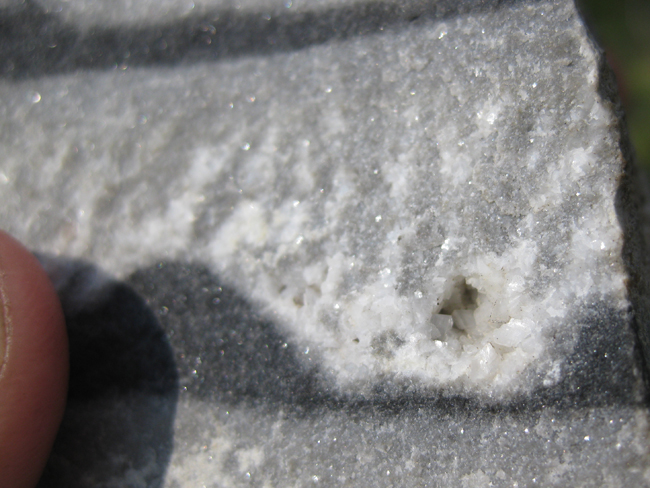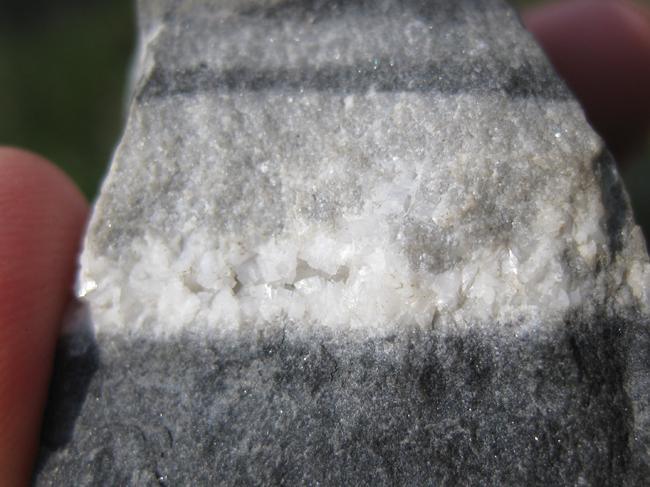Esteemed readership, I’ve got a mystery for you. What are these white lines, inclined consistently at a high angle to bedding? I picked up this sample below the “Wall of Death,” on the trail from Wapta Lake below Mount Wapta, en route to the Walcott Quarry of the Burgess Shale. The “zebra-striped” rock is of the Eldon Formation of the Cambrian section in Yoho National Park.

At first, I thought “cross-beds,” but they I realized that they were too high angle.
Here’s another side of this sample:

Tension gashes? But though they are indeed oriented subparallel to one another, they are so closely spaced, that doesn’t seem plausible.
Perhaps a clue can be found in the apparent void spaces filled with coarse dolomite crystals seen near the base of some of the white layers:

Here’s another example of that: Initially zoomed out for context…

…and then zoomed in for detail…

What about this idea?… Initial cross bedding creates small compositional variations on a geometrically regular scale. Then, during diagenetic dolomitization of a limestone protolith, the cross-beds are a site of preferential dolomitization. If shearing occurred simultaneously with the recrystallization, then that could change the orientation of the former-cross-beds in a systematic way. Perhaps this opens up new void spaces, which subsequently fill with coarse chemically-precipitated dolomite.
Problem: Dolomite is more dense than calcite, so diagenetic dolomitization should increase volume (less void space) rather than decrease it. I guess something else must be going on. Any ideas?

What about parallellism with a pre-existing tectonic cleavage fabric? These look an aweful lot like those studied by Vandeginste et al. in the Rocky Mountains or those studied by Nielsen et al. in the Brabant Massif in Belgium. Another hypothesis for their formation is given by Merino et al.
Sources:
http://onlinelibrary.wiley.com/…/j.1365-3091…/abstract
http://onlinelibrary.wiley.com/…/j.1365-3091…/abstract
http://diposit.ub.edu/dspace/handle/2445/16892
Correct links:
onlinelibrary.wiley.com/doi/10.1046/j.1365-3091.1998.00171.x/abstract
http://onlinelibrary.wiley.com/doi/10.1111/j.1365-3091.2005.00724.x/abstract
Howard Allen, a longtime commenter, had trouble getting through the Captcha spam-blocker (as have many readers in the past week — very frustrating). But he sent it to me via email, so here are his ideas – including correcting my goofy thinking about density vs. volume (oops) – and yes, Koen, it seems like cleavage is the control:
The similarity of these structures to a deep-water rock type described as ‘slurry beds’ is striking. If that’s the case, the alternating dark and light-colored bands are due to variable mud content resulting from some kind of instability in a depositing sediment-rich gravity flow (which would require relatively deep water, below the wave base); and the inclined white structures are water escape sheets. They are inclined because of shearing by the overlying flow. Some of the best examples are illustrated in this paper: Lowe, D. R., & Guy, M. (2000). Slurry-flow deposits in the Britannia Formation (Lower Cretaceous), North Sea: a new perspective on the turbidity current and debris flow problem. Sedimentology, 47, 31–70.
I saw the vugs, and thought to myself, that doesn’t look unusual — the zebra dolomite I’ve seen before has vugs in it — but didn’t take that to the next step (volume change mentioned by Howard above). Dolomite is also a better host rock for some kinds of ore deposits than massive limestone because of the volume change effect. Whether this type of dolomitization is cause by diagenesis or hydrothermal activity as reported in this article: http://geosphere.gsapubs.org/content/6/5/663 — a concept which is still debated. The zebra dolomite I’ve seen could have been the result of hydrothermal activity outboard from the “marble line” around a porphyry copper, but otherwise doesn’t look very impressive to me as an example of hydrothermal action — and certain beds seemed much more susceptible to the effect, not sure why.
Another long-time commenter, Astrid Arts, chimes in via email (blocked out by the CAPTCHA anti-spam app):